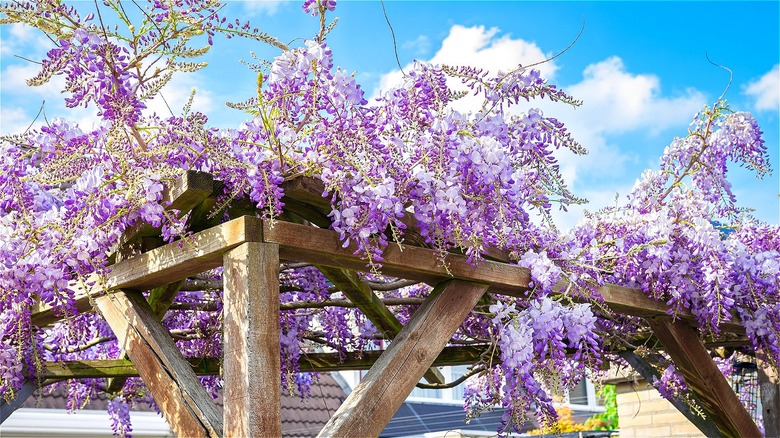The Wisteria You Want To Rethink Planting In Your Garden
Unless you have a trained eye, it may be standard to think that the purple wisteria you see scaling buildings or intertwining with tree lines is one and the same. But in reality, wisteria comes in more than a dozen varieties indigenous to several different parts of the world, some of which are more friendly than others. Commonly grown across the American Southeast, Chinese wisteria is just one of these varieties — an invasive species of flowering vine that produces fragrant blooms in vibrant shades of purple, lavender, and white. Despite their fluid and graceful appearance, these plants will go to great lengths to survive, even going so far as to kill other vegetation that interferes with their attempts to grow. For this reason, avoid planting Chinese wisteria in your home garden, as these invaders will try to compete with your other plants for space and nutrients, overtaking them if given the opportunity.
Wisteria is just one of many types of plants that show aggression and assert dominance when grown too closely to its neighbors. However, not all breeds of wisteria are threats to your garden. American wisteria and evergreen wisteria are two alternative species that can offer homeowners the colorful and aromatic qualities they crave without all of the downsides that come with attempting to control an invasive plant.
The danger of Chinese wisteria
As their name states, Chinese wisteria are flowering vines indigenous to China that arrived in America during the 19th century. Fond of warm weather with plenty of sunshine, these plants have made a home in the humid states of the Deep South, initially blossoming in April and May and lasting about three months. Chinese wisteria is considered invasive for its ability to completely displace native wildlife from its natural habitat if given free rein over a particular piece of land. The plant is capable of severely impairing an ecosystem of indigenous vegetation if left unrestrained.
Chinese wisteria has the potential to impact your garden in the same way. If grown too closely to existing plants, the wisteria's vines are positioned to compete with them for the resources they need to survive, even killing them in order to stay alive. Chinese wisteria is often found scaling trees and tangling within shrubbery as its vines grow longer and stronger with time, but these actions are catastrophic for the plants whose personal space is invaded, as they're slowly being deprived of necessary nutrients at the same time. A host tree, for example, may become strangled by a wisteria plant's vines as they climb and wrap around its trunk in search of better access to direct sunlight. Wisteria's powerful reproductive abilities can completely transform a landscape in little time, as the elimination of one tree alone can make room for additional vines to grow in place.
How to remove Chinese wisteria
Capable of growing up to 10 feet each year, wisteria can grow exceptionally fast. Thus, it's important to take action against its vines as early as possible before the potential problem spirals out of control. Wisteria spreads to new terrain through its stems and seeds, which makes the species difficult to ward off once it appears in your garden.
In order to get rid of Chinese wisteria for good, cut the vines as close to the root as you can. After cutting away the wisteria, paint over the remaining portion of the vine with glyphosate, a popular herbicide used to eliminate weeds around gardens and homes. The glyphosate will enter the plant through the opening and travel to the root, killing the plant entirely, though it may take multiple applications. If looking for an alternative solution that doesn't involve handling chemicals, you can dig the wisteria root up from the ground to eliminate any chances of the plant resprouting.
It's important to note that making a single cut at the base of your Chinese wisteria isn't enough to reverse its harmful effects. If a wisteria's vines grow to wrap around a tree, they may still harm the tree even after the connection to the root is severed. So, remove all vines when killing invasive wisteria. Be thorough when disposing of any wisteria vines, as any leftover remnants can take root and cause new vines to grow in their place.


